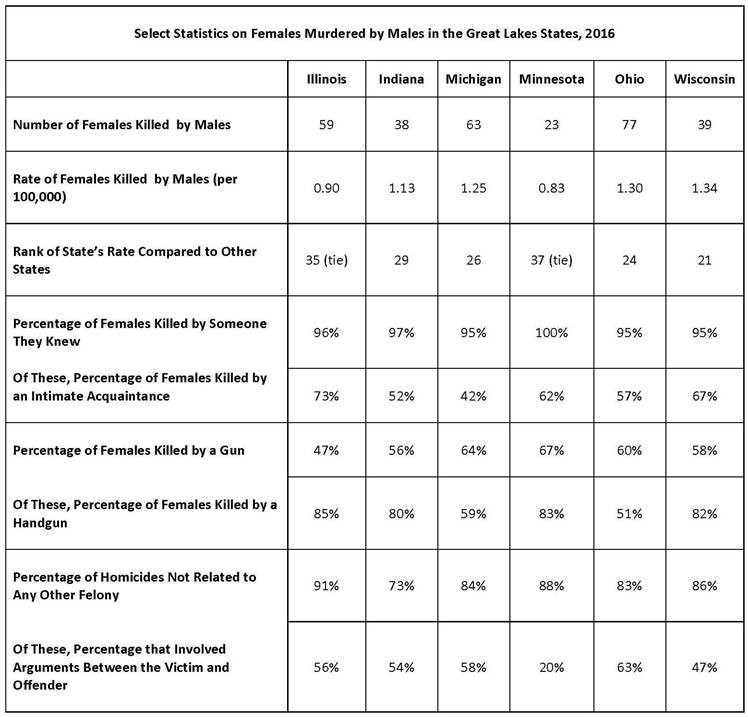For Release: Tuesday, September 18, 2018
Violence Policy Center Study Released as Federal Violence Against Women Act (VAWA) Set to Expire on September 30 and Domestic Violence Awareness Month Begins in October
Washington, DC — Women in the Great Lakes states (Illinois, Indiana, Michigan, Minnesota, Ohio, and Wisconsin) are almost always murdered by someone they know, most commonly with a gun, according to the new Violence Policy Center study When Men Murder Women—The Great Lakes States. The analysis is a regional companion report to the VPC’s annual national study When Men Murder Women: An Analysis of 2016 Homicide Data, which ranks the 50 states according to their rates of females killed by males in single victim/single offender incidents and was also released today.
Both studies are based on unpublished information from the Federal Bureau of Investigation (FBI) Supplementary Homicide Report (SHR) and detail homicide data for 2016, the most recent year for which comprehensive national data is available. Their release comes in advance of Domestic Violence Awareness Month in October and the scheduled expiration of the federal Violence Against Women Act (VAWA) on September 30. A bill to reauthorize VAWA has been introduced in the U.S. House of Representatives.
VPC Legislative Director Kristen Rand states, “The study shows that when women in the Great Lakes states are murdered it is most often by a man they know armed with a gun, and that all too often that man is an intimate partner. The study highlights the importance of renewing the Violence Against Women Act, which would expand resources devoted to keeping guns out of the hands of abusers.”
“Across the nation, state gun violence prevention organizations are working to protect women from firearms death and injury stemming from domestic violence. While progress is being made, much remains to be accomplished at the state and federal levels to safeguard women from lethal domestic violence. Renewing the Violence Against Women Act is essential to these efforts,” states Nick Wilson, national director of States United to Prevent Gun Violence, the national umbrella organization for state gun violence prevention groups.
For each of the Great Lakes states, the study offers a detailed summary including: the number of victims by age group and race; the most common weapons used; the victim to offender relationships; and, the circumstances of the homicides. The study also presents historical data for each state detailing over the past five years the number of female homicide victims, the rate of females killed by males and how it compares to other states, and the percentage of females killed with guns.
The study’s findings for the Great Lakes states include the following.
• In each of the states, 95 percent or more of the victims know their killers.
• In each of the states, guns were the most common weapon used by males to kill females.
• In each of the states, the most common firearm used by a male to kill a female was a handgun.
• In each of the states, the vast majority of the murders were not related to the commission of any other felony.
• Three states—Michigan, Ohio, and Wisconsin—had rates of females murdered by males that were above the national average.
Additional information for each state is presented in the table below.

In the study, in addition to supporting renewal of the Violence Against Women Act, the Violence Policy Center urges that state legislators adopt laws that enhance enforcement of federal legislation and ensure that guns are surrendered by or removed from the presence of abusers.
National statistics from the full When Men Murder Women study include the following.
• Across the country, 1,809 females were murdered by males in single victim/single offender incidents at a rate of 1.20 per 100,000. Of the 1,809 female homicide victims, 1,188 were white, 517 were black, 55 were Asian or Pacific Islander, 26 were American Indian or Alaskan Native, and in 23 cases the race of the victim was not identified.
• Nine out of 10 victims knew their offenders. Of the victims who knew their offenders, 63 percent were wives or other intimate acquaintances of their killers. Thirteen times as many females were murdered by a male they knew than were killed by male strangers.
• Black women are disproportionately impacted by lethal domestic violence. In 2016, black females were murdered by men at a rate of 2.62 per 100,000, more than twice the rate of 1.03 per 100,000 for white women murdered by men.
• Firearms were the weapons most commonly used by males to murder females in 2016. Nationwide, for homicides in which the weapon used could be identified, 56 percent of female victims were shot and killed with a gun. Of the homicides committed with guns, 66 percent were killed with handguns.
• The overwhelming majority of these homicides were not related to any other felony crime, such as rape or robbery. Nationwide, for homicides in which the circumstances could be identified, 82 percent of the homicides were not related to the commission of another felony. Most often, females were killed by males in the course of an argument between the victim and the offender.
The study calculates the rate of women murdered by men by dividing the total number of females murdered by males in single victim/single offender incidents by the total female population and multiplying the result by 100,000. This is the standard and accepted method of comparing fatal levels of gun violence.
When Men Murder Women—The Great Lakes States is available at: http://www.vpc.org/studies/wmmwgreatlakes18.pdf.
When Men Murder Women: An Analysis of 2016 Homicide Data is available at http://vpc.org/studies/wmmw2018.pdf. For prior editions, visit http://vpc.org/revealing-the-impacts-of-gun-violence/female-homicide-victimization-by-males/.
The Violence Policy Center is a national educational organization working to stop gun death and injury. Follow the VPC on Twitter, Facebook, and YouTube.
States United to Prevent Gun Violence (https://ceasefireusa.org/) is a grassroots network of 32 state affiliates working to make our communities and families safer.






